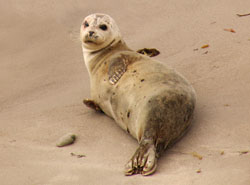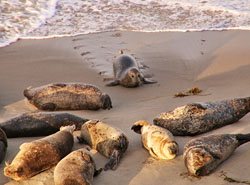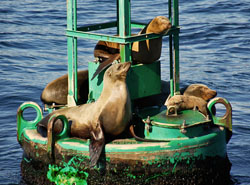- Bees
- Chickens
- Cows
- Deer
- Donkeys
- Elephants
- Frogs
- Geese
- Horses
- Lobsters
- Pigs
- Rabbits
- Rats
- Seals
- Sheep
- Turkeys
Seals

Seals can be found in all waters of the world, from the Arctic and Antarctic to tropical waters. They belong to the order Pinnipedia, which means "fin-footed". Pinnipeds have four flippers - one pair in front, and one pair in back.
There are 3 different families in the Pinnipeadia group. Phocidae (true seals), Otaridae (fur seals and sea lions) and Odobenidae (walrus). Pinnipeds, which arose from land mammals, have evolved slick bodies, ideal for gliding through water.
Pinnipeds are mammals. They're warm-blooded, give live birth, nurse their young, breathe air, and have hair. Since they live in the marine environment and find their food at sea, they are called marine mammals. Other marine mammals include whales and sea otters.

Eared seals (sea lions and fur seals) have external ear flaps and are able to use their flippers for walking on land by rotating their hind flippers forward. While swimming, they use their front flippers for power.
True seals don't have external ear flaps and can't rotate their hind flippers. On land, they pull themselves forward by their fore flippers while their hind flippers are dragged behind them. While swimming, they use their rear flippers for power.
All seals are carnivores. Their diet consists mostly of fish, crustaceans and shellfish. Depending on the season or availability, they will feed on different prey.
Unlike popular belief, seals are not at the top of the marine food chain. Orcas ("killer" whales) eat seals.

Seals are protected from the cold by a thick layer of blubber combined with a thick fur coat.
Seals use their coarse, sensitive and continuously growing whiskers to search for food. The seal sweeps its upper lip to and fro, using their whiskers to detect fish in murky waters.
Seals have large, round eyes, which are able to focus both above and below water.
Seals have an excellent sense of smell, allowing them to detect predators. Females also use their smell to recognize their pups. While swimming, the nostrils are kept tightly shut.
Seals hear very well both above and below water. Females and pups often call to each other. Seals also make growls and grunts underwater, especially during the breeding season.

Seals give birth to one pup at almost exact one-year intervals. They nurse for a brief (between 4 days and 1 month), but intense period. Most mother seals don't feed while nursing. After weaning her pup, she will have to regain her weight and rebuild her blubber stores. The mother will return to the sea to feed, while her pup is left to learn to swim and to hunt fish on its own. The pup will make the transition from dependency to independence guided almost entirely by instinct.
Male seals generally compete to get access to females. They usually mate in the few days before the females return to sea after weaning their pups. The embryo will begin to develop, but then remain suspended in the womb (this is called delayed implantation), until the female has rebuilt her blubber stores. Gestation is about 9 months.
Seals are able to hold their breath for a long times during dives, using oxygen stored in the blood and muscles as well as the lungs.
Seals can sleep underwater. They can even surface to breathe without awakening.



